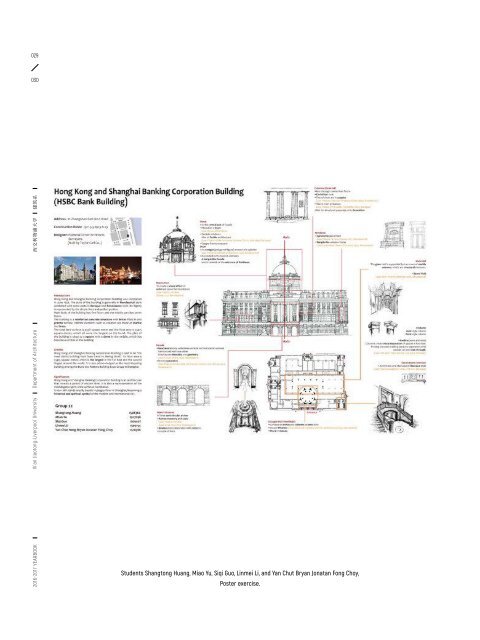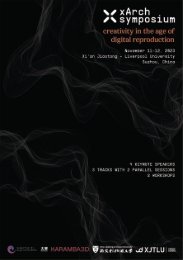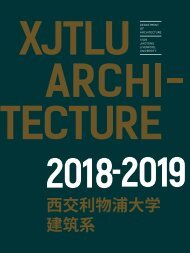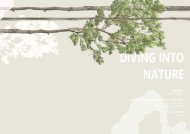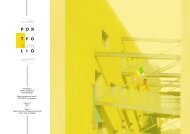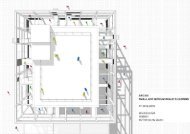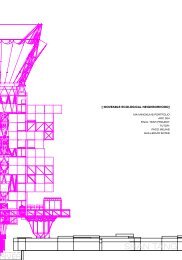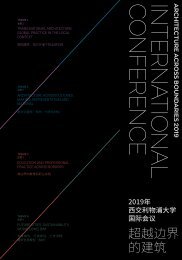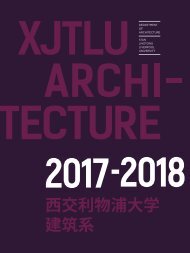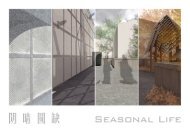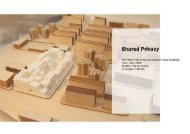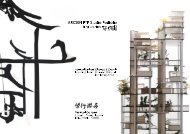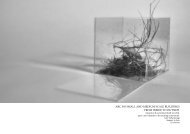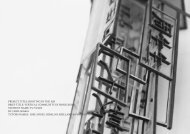YEARBOOK 2016 - 2017 | XJTLU DEPARTMENT OF ARCHITECTURE
The fourth edition of the yearbook of the Department of Architecture at Xi'an Jiaotong-Liverpool University presents student works created during the academic year 2016 - 2017. The yearbook exemplifies the new model for Chinese architectural education for which the department was commended by the Royal Institute of British Architects (RIBA). It is thus also a showcase of the creative culture that has guided our students in taking first steps to successful international careers as responsible and creative architectural designers. XJTLU offers RIBA Part 1, 2 and 3.
The fourth edition of the yearbook of the Department of Architecture at Xi'an Jiaotong-Liverpool University presents student works created during the academic year 2016 - 2017. The yearbook exemplifies the new model for Chinese architectural education for which the department was commended by the Royal Institute of British Architects (RIBA). It is thus also a showcase of the creative culture that has guided our students in taking first steps to successful international careers as responsible and creative architectural designers. XJTLU offers RIBA Part 1, 2 and 3.
Create successful ePaper yourself
Turn your PDF publications into a flip-book with our unique Google optimized e-Paper software.
029<br />
030<br />
ARC107<br />
History of Western Architecture<br />
<strong>2016</strong>-<strong>2017</strong> <strong>YEARBOOK</strong> Xi’an Jiaotong-Liverpool University Department of Architecture 西 交 利 物 浦 大 学 建 筑 系<br />
Students Shangtong Huang, Miao Yu, Siqi Guo, Linmei Li, and Yan Chut Bryan Jonatan Fong Choy,<br />
Poster exercise.<br />
Level 1<br />
( Year 2 | Semester 1 )<br />
Module Credits<br />
5<br />
Module Leader<br />
Paolo Scrivano<br />
Teaching Team<br />
Paolo Scrivano<br />
Minghao Zhang (LC)<br />
Number of Students<br />
220<br />
The aim of this module, focusing on Western Architecture from ancient<br />
times to the 21 st century, is to introduce students to the history of<br />
architecture and to engage them in a critical reading of buildings and<br />
urban settings. Buildings, cityscapes, plans, and drawings are used to<br />
illustrate how architecture reflects the culture of specific geographical<br />
locations in diverse historical moments; in addition, architectural<br />
artifacts were analyzed from different perspectives (social, cultural,<br />
economic, institutional, etc.) with the goal of helping students acquire<br />
skills in understanding the built environment and develop a critical<br />
attitude toward architectural projects of the past, the present and the<br />
future.<br />
Organized through lectures and readings, the module included also<br />
drawing and written exercises intended to initiate students to the<br />
analysis and interpretation of architectural examples, in the expectation<br />
that the familiarity with architectural history will foster future<br />
design thinking. A short research essay requires students to conduct<br />
independent research and discuss a specific building or urban setting.<br />
Some sessions are delivered by a Language Centre tutor who assists<br />
students with language/study skills requirements. Moreover, students<br />
are provided with online language/study skills support to assist in<br />
engagement with the module’s content.<br />
During the term, students participate in to a field trip to Shanghai during<br />
which they analyze a select building on the Bund: the outcome of this<br />
exercise includes a poster that included text, photographs, and drawings<br />
(plans, volumes, elevations, and architectural details).<br />
Level 01 – Year 2<br />
B Eng Architecture Programme


